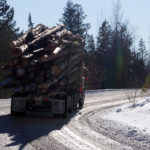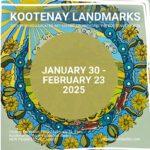Home »

Including wildlife in your holiday gift giving plans
By Mark Hall
Op-Ed Commentary
People of the East Kootenay have amazing generosity at this time of the year when it comes to raising funds and stocking up the food bank for families who are in bit more need of community support during the holiday season. For many East Kootenay residents the Christmas Season and winter will also be a time they turn their thoughts to what they can do for wildlife.
 Last winter many people were very concerned about the snow and the impact it would have on the region’s wildlife. The severity of winter is one of the most important factors limiting abundance and distribution of ungulates in the region. The winter of 2016-17 had snow depths above critical levels for deer (38 cm) for a total of 31 days. In the bad winter of 1996-97 there were 61 days where the snow depth was greater than 38 cm.
Last winter many people were very concerned about the snow and the impact it would have on the region’s wildlife. The severity of winter is one of the most important factors limiting abundance and distribution of ungulates in the region. The winter of 2016-17 had snow depths above critical levels for deer (38 cm) for a total of 31 days. In the bad winter of 1996-97 there were 61 days where the snow depth was greater than 38 cm.
Nonetheless, the winter last year was bit more challenging for animals than normal and there was likely higher than normal mortality levels in deer fawns and calf elk. On a positive note, the survival rate in 2017 for 70 collared mule deer in a local study was similar to that in 2015 and 2016 where 80% of the adult female deer survived the winter. The survival of an unfed group of collared elk being studied in the Elk Valley was also very high last winter even though there was some mortality from highway collisions. As sad as it is when yearling fawns and calves do not survive the winter the peace of mind, from a conservation perspective, is knowing that the population can rebound because the survival rate of breeding females was high.
To look more closely into claims being made about elk being killed on the railway tracks, I analyzed the data of elk railway strikes that were reported. I found it was not nearly as dramatic as what some folks were claiming last winter. There were approximately 200 elk hit on the railway between Golden and Elkford between the spring of 2016 and spring of 2017. That’s still a lot of elk but the data did not substantiate claims that herds of elk numbering 25 to 50 animals were being killed each day by trains last winter.
The slightly deeper snow last winter brought with it a fair share of controversy over the attempts of private citizens to feed elk and deer. In an article I published last winter I outlined what wildlife scientists and biologists across North America say about the dangers of artificially feeding ungulates. The weight of evidence tips the scale that artificially feeding wildlife is not a good idea and, in some cases, can do more harm to habitat, individual animals and entire populations than good.
We know from wildlife experts that the most important factor that determines whether deer and elk survive the winter is not the quality of food they get during the winter. For adult females and their offspring, their ability to survive winter is highly dependent on their body mass going into winter. Their body mass is linked to the nutritional value of the food they consume on their spring-summer ranges. Spring-summer range nutrition is linked to the overall health of their habitat and how much precipitation there is during the early summer growing season. For bull elk, their winter survival is linked to the quality of the food they consume after the fall rut not what they eat once they get to the winter range.
Like bears, elk and deer need to be good and fat before winter to have enough fat and protein reserves to carry them through the winter. Elk and deer are adapted to northern climates in a unique way that sees their metabolic rates slow down during the winter. Slower metabolic rates help ensure they can just calmly ride out winter by slowly using their fat and protein stores. Elk and deer still browse and graze during the winter; however, the nutritional value of grass and shrubs during the winter is much lower compared to their spring-summer forage.

This is nature’s failsafe strategy. Low nutrition food during the winter keeps their metabolic rate down thus giving the animals the best chances of maintaining fat and protein reserves through the entire winter. If the animals receive high nutrient food in the middle of the winter, like they do from artificial feeding programs, their metabolic rate increases and the speed at which they burn up their stored fat reserves increases. Burning fat reserves at a faster rate, in turn puts them more at risk of dying from malnutrition in the late stages of winter.
Artificial feeding could result in more animals dying during the winter than if nature was left alone to do its own thing. Artificially feeding elk and deer can also cause abrupt changes in their diet that inhibits their ability to digest food. This can then lead to undigested food blocking their intestines and an agonizing death from bloating. Dry feed like hay, grain, corn, oats and fruit can do this to an ungulate. Products like molasses can cause severe diarrhea leading to death by dehydration. People will rarely see animals dying from bloating or other complications because sick animals often become solitary and seek out thick cover where they hide and try to recover.
One of the most serious emerging concerns over artificial winter-feeding in western North America is the risk of spreading the fatal Chronic Wasting Disease (CWD). The prions that cause CWD cannot be killed by modern sterilization chemicals or incineration. CWD prions can attach to plants and soil when an infected animal urinates. The prions can then infect healthy animals that come in contact with the soil or by eating infected plants.
CWD occurs in deer in Alberta and five cases were just confirmed in mule deer in Montana. Local studies have shown Kootenay deer migrate between both these regions. Hay also is imported unchecked into B.C. from Alberta. The recent cases of CWD discovered in Montana prompted the Montana government to request that the state of Wyoming stop the elk feeding program near Jackson Hole.
Studies done in Wyoming have found CWD positive deer near elk feeding sites. Once CWD gets into the soil at a feeding site it has the ability to infect entire populations of ungulates for decades. Trans-boundary migrating deer and importing hay are the two most likely ways CWD will find its way to the East Kootenay. Artificial feeding sites are the locations that could become ground zero for an epidemic outbreak of CWD in B.C. Some experts claim the best method of preventing CWD from spreading across large areas of the landscape is through complete eradication of all animals when CWD is first detected in a new area.
In B.C., provincial wildlife policy discourages artificial feeding of wildlife; however, the Wildlife Act does not currently make it illegal. When private citizens or groups decide to undertake large-scale feeding programs on their own they may be jeopardizing populations of wild ungulates across the entire province. CWD spread from eastern North America to western North American decades faster that what was predicted when it first was discovered. Without artificial feeding programs being regulated there are no controls, assurances or accountability that ensures feed is not brought into B.C. from a CWD positive regions like Alberta. Promises can be made that the hay is purchased locally but at the end of the day there are no regulatory controls guaranteeing that the government is protecting the people’s wildlife from the risks of artificial feeding.
Wildlife in B.C. does not belong to the government, private landowners, hunters, conservation NGOs or non-profit societies. Wildlife belongs to the people of B.C.; all 4.7 million of us. Non-migratory wildlife is managed by the provincial government. When the Dominion of Canada was established all provincial governments were given the responsibility under the British North America Act to hold wildlife in trust for the people of the provinces.
When vigilantes decide to manage the public’s wildlife including large-scale feeding programs or poisoning wolves, you have the right to say ‘hang on a minute here these animals belong to me and I want a say in what happens to them.’
Unfortunately, B.C.’s Wildlife Act leaves the government with no legal way to act on your behalf to stop others from feeding ungulates unless it can be proven feeding harmed or directly killed the animals. A few us in the province; however, are working with government to change policy and the legislation to give enforcement officers authority to stop vigilante feeding programs. Under well-written legislation, government biologists would be the ones authorizing and approving any feeding programs and ensuring feed will be free of CWD-causing prions.
 Like any fundraising campaign that appeals to your emotions (i.e., act now the deer and elk are starving) you should be objective and critical of any claims made before you write a cheque.
Like any fundraising campaign that appeals to your emotions (i.e., act now the deer and elk are starving) you should be objective and critical of any claims made before you write a cheque.
There were no formal studies done last winter that can prove that the elk that were fed hay had higher survival rates than elk that were not fed hay. Any such claims will either be speculation or just personal opinions. If you hear that thousands of deer and elk were fed please stop and ask yourself if that number of animals is significant to the overall population across the entire southeast corner of the province. Did feeding that many animals override the power of nature to the extent that it changed the amplitude of a natural population cycle?
Ask yourself, how can anyone prove whether each animal got exactly the right amount of feed each day until the spring arrived? Why did animals that were not fed still survive? Why were there dead animals in close proximity to feeding sites?
Wildlife belongs to you. The Crown lands they live on also belong to you. If you see anyone feeding wildlife, whether on Crown or private land, that you feel is harming wildlife call the provincial RAPP hotline at 1-877-952-7277.
If you see people dumping large amounts of hay on your public Crown land it may be a potential violation of the Land Act with respect to unauthorized use of Crown land. You can report unauthorized uses of Crown land to the same 1 877-952-7277 number. You can also download and install the BC Wildlife Federation’s Conservation app on your smart phone and report environmental and wildlife violations right from your cell phone. These reports along with your photos will be directed to the appropriate compliance and enforcement agency.
If you want to include wildlife in your holiday gift giving plan this winter consider giving wildlife the gift of habitat rather than hay.
Healthy, well-managed habitat will last longer and benefit more generations of wildlife and many more species than just deer and elk. Consider making donations to the Habitat Conversation Trust Foundation or Ducks Unlimited Canada, which will invest your donation into valuable habitat enhancement projects in the Kootenay region. You can also donate to the Nature Trust of BC or Nature Conservancy of Canada which both purchase and manage biodiversity conservation properties in the Kootenays. All these organizations have diverse stakeholder Boards of Directors and expert panels than review and decide the best way to invest money into wildlife conservation. By donating to well-established habitat conservation organizations such as these ones you can have the peace of mind knowing your donations will truly help wildlife over the long-term.







